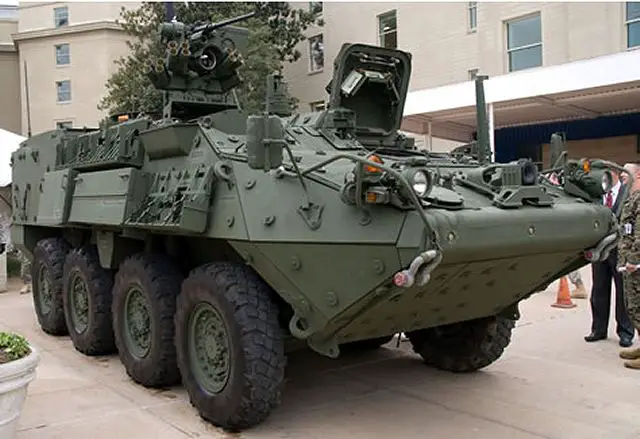| a | |||
Defence & Security News - United States |
|||
| Tuesday, September 17, 2013 10:00 AM | |||
| U.S. Army received approval to begin procurement of Stryker Double V-Hull armoured vehicles. | |||
The Project
Manager for the U.S. Stryker Brigade Combat Team received the approval
from the Army Acquisition Executive to begin the procurement of a 3rd
brigade of Stryker Double V-Hull vehicles. The United States Army currently
has nine Stryker Brigade Combat Teams with the traditional flat-bottom
hull, and two with the newer Double V-Hull, or DVH, design. The procurement
of the 3rd brigade will be made by exchanging one flat bottom hull brigade
for a newer DVH. |
|||
 The Stryker Double V-Hull armoured vehicle is more protected against land mines and IED blast. |
|||
The initial 66 vehicles are being awarded now, with the remainder planned in the future. The procurement of the 3rd brigade, which consists of 337 total vehicles, will be based on the availability of funding using an incremental approach. The Army expects to execute the entire procurement during fiscal years 2014-2016, subject to availability of funding. "While the fleet as a whole will be more modernized the total number of Strykers within the Army's inventory will go unchanged," said David Dopp, the project manager for the Stryker Brigade Combat Team. The new DVH brigade will be produced using the Stryker Exchange Program which was initiated by the Project Manager for the Stryker Brigade Combat, in partnership with Anniston Army Depot, Ala., and General Dynamics Land Systems, in response to an Army requirement for additional DVH vehicles at a reduced overall cost. "To maximize the use of fiscal resources, the Army and General Dynamics developed the DVH exchange program to validate if components from the traditional Stryker [flat-bottom hull] variants could be expeditiously refurbished and installed on a new, more survivable DVH, at less cost than producing a new vehicle," said Dopp. The process includes reusing common parts from flat-bottom hulls, refurbishing them, and re-using the parts in the new DVH structure. The initial exchange vehicles were so successful that the Army has agreed to produce the 337 vehicles of the new brigade using this process. "This is a solid example of how the Army and industry are working together to find mutually beneficial solutions to common challenges. These types of partnerships between the Army and industry are critical, especially as we continue to look for ways to modernize the Army's Stryker fleet to get the best vehicles to our Soldiers, while trying to minimize costs to the taxpayer," said Brig. Gen. David Bassett, the Army's program executive officer for Ground Combat Systems. |
|||
U.S. Army received approval to begin procurement of Stryker Double V-Hull armoured vehicles 1709134
- Posted On














